- Home
- Listings
- Things To See & Do
- Car Hire
- News
- Properties
- What’s On
ES
Salobreña
Exploring the Enchanting Beauty of Salobreña: A Gem of the Mediterranean
Nestled along the picturesque coastline of the Mediterranean Sea, Salobreña stands as a testament to the captivating allure of Spain’s southern region. With its pristine beaches, historic architecture, and vibrant culture, this coastal town has earned its reputation as a hidden gem that embodies the essence of Andalusia. From the ancient Moorish castle that dominates the skyline to the tranquil waves that kiss its shores, Salobreña offers an immersive experience that enchants the senses and captures the heart.
A Glimpse into History
Salobreña’s history is as rich and varied as the tapestry of cultures that have left their mark upon its landscape. Its most iconic landmark, the Salobreña Castle, is a testament to the town’s Moorish past. Perched atop a rocky hill, the castle dates back to the Nasrid dynasty’s reign in the 10th century. Its strategic location offers panoramic views of the town below, the azure Mediterranean waters, and the Sierra Nevada mountains in the distance. Visitors are transported back in time as they explore the castle’s well-preserved walls, towers, and labyrinthine pathways.
The town’s whitewashed houses, narrow cobblestone streets, and vibrant bougainvillaea contribute to a timeless ambiance that hints at its historical significance. The Iglesia de Nuestra Señora del Rosario, a 16th-century church, is a prime example of the architectural fusion that defines Salobreña, blending Gothic, Renaissance, and Mudejar styles.
Sensory Delights and Culinary Pleasures
Salobreña’s charm extends to its culinary offerings, which provide a tantalizing blend of flavors that reflect its coastal location and Andalusian heritage. With its proximity to the sea, fresh seafood takes center stage on many menus. Visitors can indulge in a gastronomic journey through local dishes such as “pescaíto frito” (fried fish), “gambas al pil-pil” (garlic prawns), and “espetos de sardinas” (grilled sardines on skewers).
In addition to seafood, the town’s cuisine celebrates the bounty of the surrounding land. Traditional dishes like “plato alpujarreño,” a hearty casserole featuring sausage, eggs, and potatoes, provide a taste of the rustic countryside. The unique blend of Moorish and Spanish influences is also evident in Salobreña’s sweet offerings, including almond-based confections and honey-infused pastries.
Nature’s Oasis
While Salobreña is renowned for its historical and cultural attractions, its natural beauty is equally captivating. The town’s coastline boasts a series of pristine beaches that offer respite and relaxation. Playa de la Charca and Playa de la Guardia are two popular options, each with its own distinct character. The former is known for its calm waters and family-friendly atmosphere, while the latter entices visitors with its golden sands and excellent water sports opportunities.
For those seeking to escape the sun-drenched shores, the Sierra Nevada mountains provide a dramatic backdrop. A short drive from Salobreña leads to this rugged wilderness, where outdoor enthusiasts can embark on hiking trails that meander through forests, meadows, and crystal-clear streams. The contrast between the coastal oasis and the mountainous sanctuary highlights the region’s diverse natural beauty.
Festivals and Traditions
Salobreña’s vibrant cultural scene is punctuated by a calendar of lively festivals that showcase the town’s zest for life and its deep-rooted traditions. The Fiestas de San Juan, celebrated during the summer solstice, are a testament to the town’s Moorish heritage, with bonfires, music, and dancing that create an electric atmosphere. The Semana Santa (Holy Week) processions offer a more solemn but equally captivating experience, with intricately adorned floats and passionate displays of devotion.
Capturing Hearts
Salobreña’s ability to capture the hearts of both locals and visitors lies in its harmonious blend of history, nature, and culture. Its distinct character, shaped by centuries of influences, is a testament to the enduring spirit of the Mediterranean. Whether it’s the imposing castle that evokes a sense of wonder, the scent of freshly caught seafood wafting through the air, or the warm embrace of the sun as it sets over the horizon, Salobreña weaves a tapestry of experiences that lingers long after one’s departure.
In an era of bustling tourist destinations, Salobreña remains a tranquil haven that invites travelers to slow down, savor the moment, and immerse themselves in the captivating stories etched into its cobblestone streets and ancient walls. This hidden gem along the Mediterranean coast is a testament to the power of place — a place where time seems to stand still, and the soul finds solace in the beauty of the world.
In conclusion, Salobreña’s enchanting beauty is a reflection of its historical significance, cultural richness, and natural splendor. This coastal town is a reminder that there are still hidden corners of the world that hold the power to inspire, captivate, and rejuvenate the human spirit. Whether exploring its ancient castle, indulging in its culinary delights, or simply basking on its sun-kissed beaches, Salobreña offers an unforgettable journey through time and culture, leaving an indelible mark on those fortunate enough to experience its magic.
You may also be interested in:
Places to visit in Salobreña
Salobreña Castle
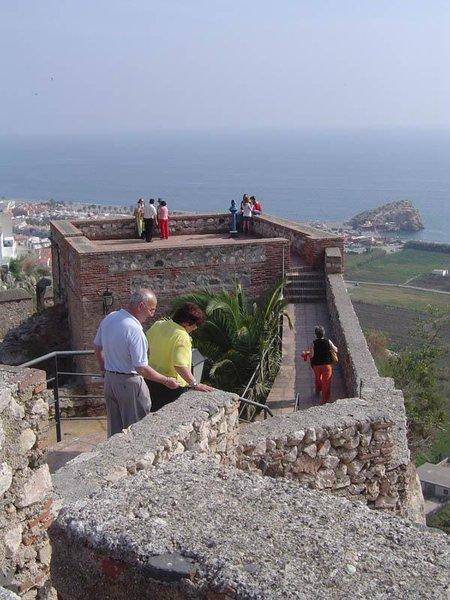
The existence of a fortification in Salobreña has been known since the 10th century. While the layout corresponds to the construction erected during the Nasrid period, the Arab castle is the result of both Muslim and Christian architectural contributions.
During the Nasrid period, it housed a royal palace used for rest, which also served as a royal prison.
The castle was conquered by the Catholic Monarchs in 1489.
The castle retained its military significance until the late 18th century.
Reports from 1739 indicate that it was abandoned and in significant disrepair.
It did not have a specific or utilitarian function, as it did not serve for coastal defense. Nevertheless, the cavalry assigned to the castle had the mission of patrolling from La Caleta to the mouth of the Guadalfeo River.
Starting in 1849, it was used by the customs officers, who established a signaling post within it.
From its towers, one can admire the urban layout of Salobreña, the fertile plain, the Mediterranean Sea, the adjacent mountain ranges, and even Sierra Nevada.
Visiting hours:
June 15-Agust 31: 10am – 1:30pm / 5:30pm – 8pm.
September until last Saturday in October: 10am – 2pm / 5-7:30pm.
Last Sunday in October until- February 28: 10am – 2pm / 4-6pm /
March 1- last Saturday in March: 10am – 2pm / 5-7pm.
Last sunday in March until June 14th: 10am – 2pm / 5:30-8:30pm.
Last access is 30 minutes before the closing.
Closed on December 24th, 25th and 31st, January 1st.
Prices: adults:4 euros, free for children younger than 12 years old
Location: Calle Paseo de las Flores, s/n, 18680.
Telephone: 958610314
Mirador Enrique Morente
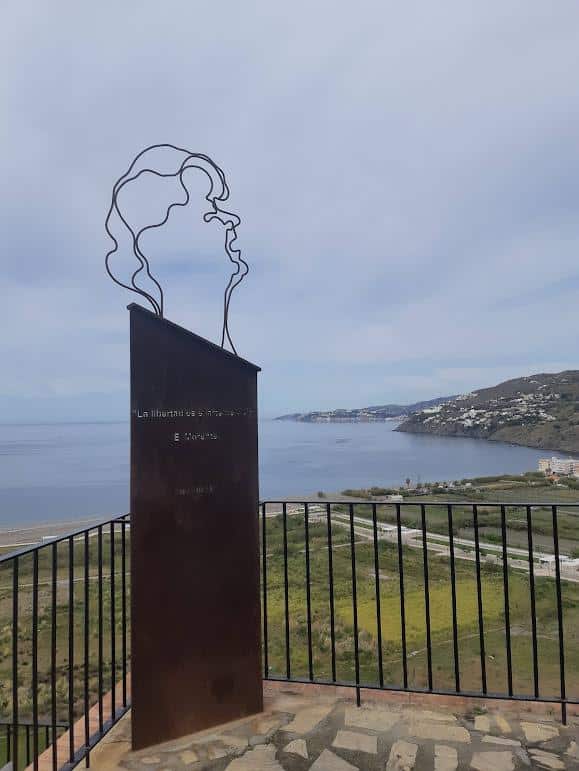
The Mirador Enrique Morente in Salobreña is a breathtaking viewpoint named in honor of the legendary Spanish flamenco singer, Enrique Morente. Located atop a hill, it offers visitors an unparalleled panoramic view of the town of Salobreña, the Mediterranean Sea, and the picturesque surrounding landscapes.
Perched high above, the Mirador Enrique Morente provides a captivating vista that stretches far and wide, showcasing the town’s white-washed buildings, the ancient Moorish castle, La Caleta, Sierra del Chaparral, and the deep blue sea merging with the horizon. It’s a place where visitors can immerse themselves in the beauty of the Andalusian coastline.
The Mirador is a popular destination for both locals and tourists alike..
As the sun sets over the horizon, casting hues of orange and pink across the sky, the Mirador Enrique Morente transforms into a magical place. The town below is bathed in a warm, golden light, creating a scene straight out of a postcard.
Whether you’re a music enthusiast paying homage to Enrique Morente or a traveler seeking a place of natural beauty and serenity, the Mirador Enrique Morente in Salobreña offers an unforgettable experience. It’s a place where history, culture, and nature converge, leaving visitors with memories that will last a lifetime.
We reccommend getting there walking since access by car is narrow, and there is limited parking available especially during the summer months.
La Bóveda
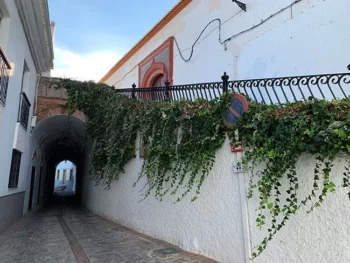
It is a beautiful vaulted passage that connected the Albaicín neighborhood with the core of the old medina. Built in the 16th century, the lateral access is a small gate leading to the walled city. It features a semicircular barrel vault that is supported externally by a section of the old city wall. It was primarily used for the entry of merchants.
Calles Bovedilla y del Arco

From the toponymy of the 18th century, we know of the existence of covered and vaulted streets that are so characteristic of the Islamic street layout, as is the case with Bovedilla Street and Arco Street. The winding and narrow urban layout was primarily a practical response, as it was, in fact, an adaptation to the terrain.
Mirador del Postigo
Its name comes from the existence of a secondary gate of the medieval city in this location. It is a balcony overlooking the northern area of Salobreña, from which you can see the highest mountain in the region, the “Pico de la Guindalera,” standing at 1,072 meters in height. It can be accessed through a staircase from the Postigo Park.
Paseo de las Flores
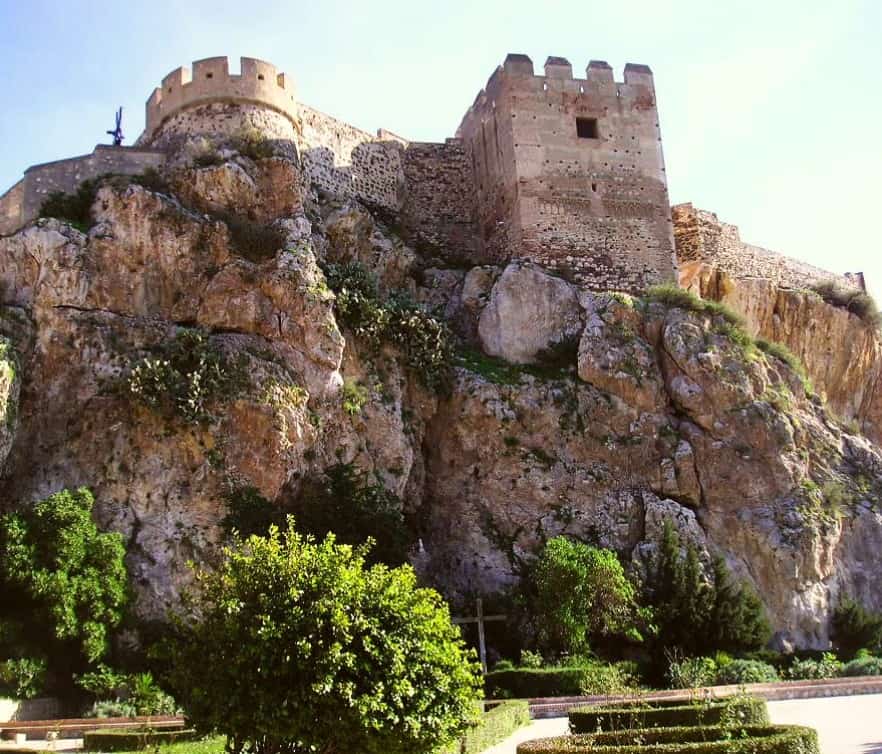
Beautiful promenade located at the foot of the Salobreña Castle. This slope was settled by the first inhabitants of the rock (3000-2000 BC) and numerous archaeological remains have been found. Today, it is one of the most beautiful spots from which you can enjoy the wonderful views of the Mediterranean Sea, with the backdrop of the Sierra Nevada mountain range.It is surrounded by lovely and well-maintained gardens with various species of shrubs, flowers, and palm trees planted along its path. In October, the Paseo de las Flores hosts a showcase of crafts and gastronomy in celebration of the Feast of the Virgin of the Rosary.
Peñon de Salobreña
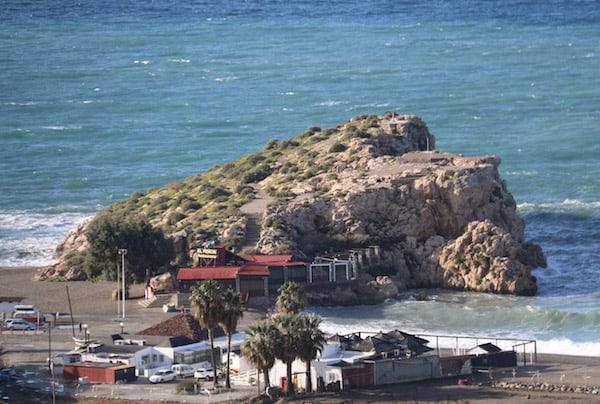
The Coast of Granada boasts rocky cliffs of extraordinary beauty, but they can also be dangerous. The Salobreña Rock is one of these extraordinary places, from which numerous swimmers jump in for a dip. In ancient times, this area was actually an island, positioned approximately five hundred meters off the coastline. Composed of limestone and dolomite marbles, the rock carries significant archaeological importance. Over the years, it has yielded ceramic fragments dating from Prehistoric to Medieval times, along with traces of structures, burial sites, and even remnants of ancient salted fish processing pools.
Albaycin quarter
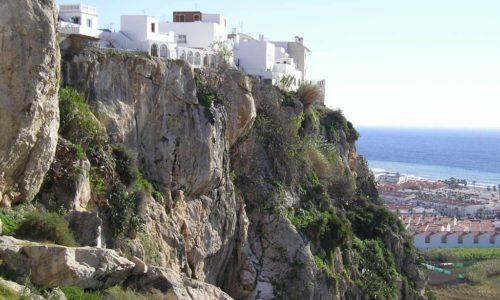
District located near the fortress, around which the population gradually settled. It served as the Christian cemetery from 1788 until 1898. The viewpoint, 98 metres above the Río Tajo, offers a spectacular view of the valley, the La Caleta neighbourhood, beaches, cliffs and the Sierra del Chaparral. We suggest wandering through its labyrinthine streets discovering whitewashed houses decorated with flowers. The Albaicín also houses significant landmarks, including the Church of Nuestra Señora del Rosario, built on the site of an ancient mosque. Its Mudejar-style tower and ornate azulejo decoration are noteworthy.
Brocal quarter
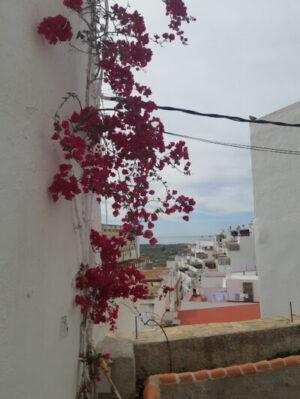
Its streets were built following the layout of the Salobreña Wall. Only the remains of one of its towers, called ‘El Torreón’, still stand. The lower part of the Brocal neighborhood was born outside the walls, creating what were called ‘suburbs’. It’s beautiful to explore its streets, labyrinthine with corners, facades decorated with geraneums and buganvillas, and more.
Gambullón viewpoint and quarter
It is located at the base of the cliff and connects the Paseo de las Flores with the lower Vega area, bridging the rural surroundings and the old town through a path known for its historical and scenic significance. These beautiful gardens have a play area for children and are interesting for birdwatching, as various bird species nest in the cliff.
La Caleta
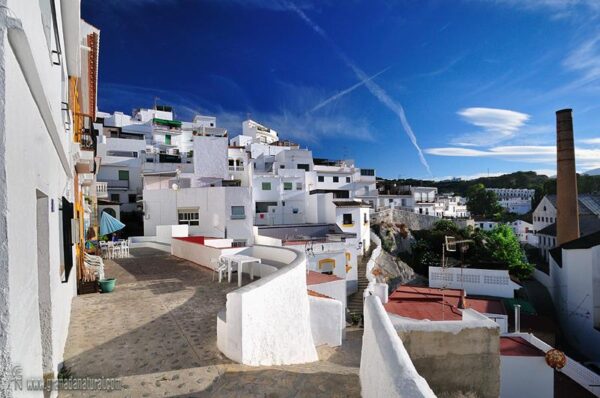
La Caleta is a district of Salobreña, located in the central-western part of the Costa Granadina. It is home to the last remaining sugar factory in Europe, built in the 19th century. During the visit, visitors receive explanations about its history and the production process.
Parque de La Fuente
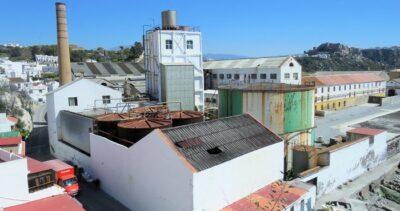
Located on Avenida del Mediterráneo, close to the beach, this large green space in Salobreña is home to numerous species of plants and flowers, as well as birds and other small animals. There is a playground area for children, and it is often used as a venue for events and cultural activities.
Beaches

Along about 6 km of coastline, Salobreña boasts up to 4 beaches (La Guardia, Peñón Beach, Charca Beach, and Punta del Río Beach) and 3 coves (Caletón Cove, Pargo Cove, and Cambrón Cove).
Casa Roja / Fundación Martín Recuerda
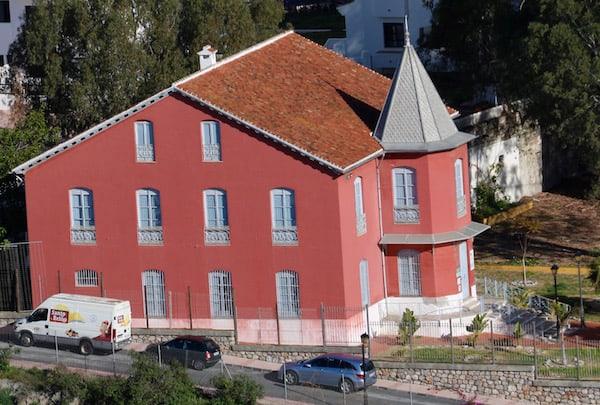
Constructed in 1905 by the proprietors of the San Francisco Sugar Mill, this house boasts a prominent polygonal tower with an ornate spire as its centerpiece. Inside, the grandeur and style of its era have been meticulously preserved. Currently, it serves as the location for Municipal Offices and the Visitor Center of the Martín Recuerda Foundation. Martín Recuerda, an esteemed Spanish writer and recipient of Spain’s National Theater Award, once called Salobreña home and eventually passed away here.
La Caleta Sugar Factory

The sugar mill in La Caleta, built in 1861, holds significant historical value. It stands as the only factory in Europe that, for over a century, processed sugarcane to produce sugar, syrups, and alcohols for rum production and more. Closed in 2006, it is classified as a Cultural Heritage Site in Andalusia.
